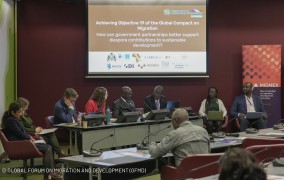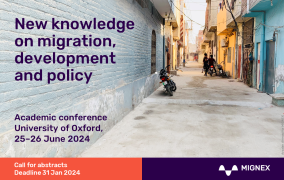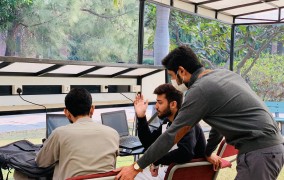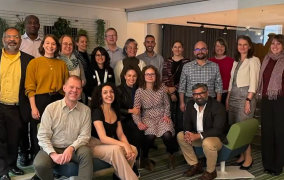MIGNEX Insight
Wandering and waiting: field observations as a key tool for qualitative data collection
When done strategically, field observations are an integral tool to qualitative data collection methods. Based on our approach tested in Tunisia, we outline how collecting informal data through waiting and wandering can provide insights and help to achieve the overall research objectives of field research.
Recently completed MIGNEX qualitative fieldwork in two Research Areas in Tunisia involved much waiting and wandering. Waiting for offices to open and for officials to usher us in; wandering into eye-catching shops to strike up conversations with the owners. Walking around residential areas to catch pictures of doors and the attention of neighbours; waiting at (outdoor, socially distanced) café tables for interview participants to arrive.
Where collecting quantitative surveys can produce an immediately tangible and specific outcome, collecting field observations through waiting and wandering may at the surface seem less efficient. There is, however, a method to the madness, as anyone working with ethnographic methods will recognise. The experience of WP4 fieldwork in Tunisia highlighted three best practices for implementing strategic, active, and focused wandering and waiting. Done with purpose, these practices can help to achieve the overall research objectives.
Be strategic and have a (flexible) plan
While wandering and waiting can be valuable, it is counterproductive on its own without a plan. In Tunisia we always started with a plan and a list of the categories of people we wanted to speak to, tailored to the research context and our MIGNEX research objectives. This list included common categories – such as municipal actors, someone in education, private sector actors, civil society actors – but also categories unique to specific development and migration dynamics.
With this list as a starting point, our strategy was to begin at the top, introducing ourselves and scheduling interview appointments with those on the highest rungs of formal government, before working our way down. The waiting and wandering happened in between these formal appointments, allowing us to both include municipal perceptions while also going beyond these.
Planning did not end with the initial field plan. Each evening, based on the accomplishments of the day, we would strategise for the next. We adapted this planning on a daily basis as we collected new information, met new people, and identified remaining gaps based on MIGNEX research theme lists.
Be active – ask questions whenever, wherever
Active wandering and waiting ensures that it is productive and can feed into the wider field observations and narratives of the research areas. In my experience, being “active” involves asking questions – questions about anything and everything we see, and questions that may fall outside of the format and structure of interviews and focus group discussions.
In some cases, answers might not lead to anything relevant. But more often than not, these informal discussions test assumptions and uncover dynamics that may not be immediately apparent in initial interviews. While waiting for formal focus group discussion participants to arrive, we conducted informal chats with young people hanging out at a youth centre. These conversations revealed, for instance, a preference for learning and speaking English over French as a second language, and the generational and class perceptions of the two languages. Beyond this, questions offer an opportunity to approach less formal actors for answers, to introduce MIGNEX as a project, and build on these questions and observations to identify potential research participants.
Be focused – don’t lose sight of your research objectives
Keeping sight of research objectives is vital for remaining focused – and this goes beyond merely keeping research questions in mind. In Tunisia, for instance, we kept focus while wandering and waiting during field observation by:
Identifying informal observations
In between appointments, we reviewed printouts of MIGNEX themes and worked to identify how our field observations already linked to certain categories and which categories needed more attention. These observations are often as much about what is not seen as what is.
In both Tunisian research areas, for instance, the lack of visible hotels in town provided an indication on low levels of tourism, even before this was further confirmed in more formal interviews and group discussions.
Capturing informal observations
Moments waiting or wandering were also the moments when we were able to take the most photos, capturing observations at various times and from various perspectives. Writing down notes and reflections throughout the day helped to ensure that observations did not simply become memories but could be formulated as a tangible and shareable research output.
I found it easiest to make these notes on my phone throughout the day, separate from formal interview and group discussion notes. Recorded voice notes, notebooks, or illustrations might also all be effective ways of capturing informal observation moments.
Debriefing and reflecting
At the end of each day, our small team would sit together to debrief. We would reflect on findings and observations from both formal interviews and outcomes from our informal observations. These debriefs informed daily planning and allowed us to ensure that improvised or ad hoc observation moments remained relevant and incorporated into overall research insights.
Context is key
Our ability to wander and wait were also specific to our research areas. We were working in a physically safe and secure context, combined with a culture of hospitality, which facilitated local support for our fieldwork and identification of contacts. This may not be fully replicable in all contexts.
However, finding adapted ways to incorporate strategic, active, and focused wandering and waiting moments into fieldwork provides an invaluable way to achieve insights into research areas.





